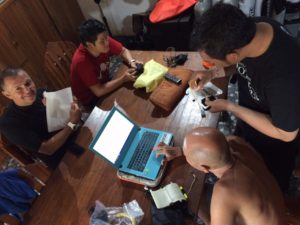Technical diving can seem daunting to new divers, with a plethora of courses, equipment and skills to learn. With that in mind, we’ve compiled a tech-diving alphabet as an introduction to some essential skills and terms for the sport. Here’s part two, which takes us from “E” for equipment through “H,” for hypoxia and hyperoxia.
E is for Equipment
Out of all technical-diving aspects, equipment needs and choices can be the most intimidating. Technical divers carry far more equipment than recreational divers. This is largely because technical dives often involve going deeper and breathing more gas due to the increased ambient pressure. Consequently, tech divers use doubles/twinsets or sidemount tanks, plus additional tanks to complete their decompression stops. Each of these requires its own first and second stage regulator, SPG and possibly other accessories. This is in accordance with the principle of redundancy, which requires each diver to carry a back-up of any life support equipment.
Life support includes more items than you may initially think, including tanks, gas and regulators, of course, but also a back-up mask and cutting devices. You’ll also likely want to purchase a computer designed specifically for technical diving.
Equipment quality is also crucial. Diving deep or entering overhead environments puts a strain on gear, so high-performance equipment is a must. Additionally, the regulators you use for high-oxygen decompression gases must be oxygen-clean. All told, technical divers simply face more detailed considerations than their recreational colleagues.
F is for your First Time Leading a tech dive
Most students in technical-diving courses come from a recreational-diving background and are often used to following a dive guide. In fact, they may never have been in a situation where they led a whole dive. Dive professionals ‘going tech’ have a bit of an advantage here, because leading dives is already part of their everyday life.
During technical courses, instructors train their students to deal with equipment failures, plan a dive and follow that plan — and they will expect their students to lead dives. Why? Because after certification, the instructor is no longer there to lead the way.
All this training stretches a student’s comfort zone. And often, that first time ‘being out front’ has a bigger impact on the diver’s performance than all the previous failure drills. Picking the right pace for a dive and ensuring the team is on track when it comes to executing the dive plan can be tricky at first. Having said that, once a diver becomes comfortable leading dives, their general confidence underwater grows.
G is for Gradient Factors

Gradient factors have become a staple of decompression-dive planning. Modern decompression-planning algorithms largely fall into modified/neo-Haldanean types, basing their predictions on tissue compartments and dual-phase bubble models that try to control the size and number of nitrogen bubbles forming in the diver’s body on ascent.
Gradient factors have become a popular tweak, which we apply to tissue-compartment models, allowing divers to personalize their ascent. Divers can determine how deep their decompression stops start as well as how much over-pressurization they want to allow in their tissues on ascent.
With each ascent from a dive, recreational or technical, divers search for the perfect balance between on-gassing and off-gassing. For recreational divers, this means staying within no-stop limits and conducting a three-minute safety stop at 15 feet (5 m). Technical divers, on the other hand, deliberately exceed their no-stop limits, heading closer to tissue saturation. On ascent, they must often complete several decompression stops of varying lengths. Where these stops start and how long they last can change based on the gradient we allow between ambient pressure surrounding the diver and remaining tissue pressure, thus determining the speed of ascent from a technical dive.
H is for Hypoxia and Hyperoxia
When it comes to diving, we must ensure that the oxygen in our gas mixture is just right, breathing not too much and not too little.
Divers face hyperoxia, or oxygen toxicity, when they breathe too much oxygen. This is not only a concern for technical divers, but also nitrox divers who must stay within their maximum operating depths, or MOD. Technical divers utilize high-oxygen gases to accelerate their decompression stops. Put very simply, they try to maximize time at depth while minimizing time spent on decompression stops. Using these gases efficiently means switching to them as soon as safely possible. This is a crucial part of any technical dive, as dropping deeper at this point means risking hyperoxia.
Hypoxia, the opposite of hyperoxia, refers to too little oxygen. This is mostly a concern for closed-circuit rebreather divers (CCR) ascending from a dive. As ambient pressure around the diver drops, so does the partial pressure of the gas they are breathing. At that point, CCR divers must make sure they’re breathing a sufficient amount of oxygen.
Hypoxic trimix divers deliberately choose a gas mix with low enough oxygen content to avoid hyperoxia at depth. They must also carry a gas that has enough oxygen to be breathable from the surface to a depth where they can switch to their bottom mix. As with many aspects of diving, it’s all about finding the right balance to dive safely.



